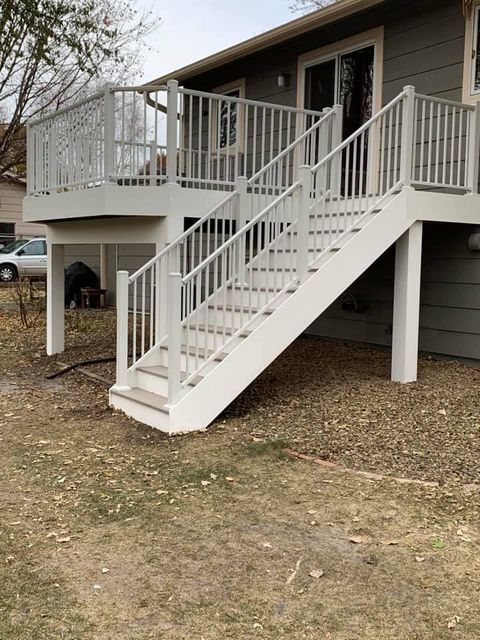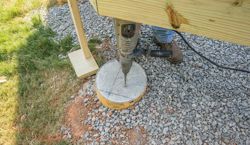Expert Tips for Setting Up Deck Footings to Support Your Outdoor Room
When it involves building a deck, one of one of the most vital elements to think about is the installation of appropriate grounds. These grounds are the foundation whereupon your outdoor area will certainly rest, giving stability and assistance for several years to come. Yet exactly what does it take to install deck grounds properly? In this discussion, we will check out experienced ideas and techniques that can aid ensure a successful and sturdy deck installation. From selecting the ideal kind of footings to avoiding typical blunders, we will certainly give you with the knowledge and insights you need to confidently start your deck-building journey. So, let's dive right in and find the secret to a long-lasting and solid outside room.
Significance of Appropriate Deck Footings
Proper deck footings are vital for guaranteeing the security and long life of your outside space. Without solid and appropriately set up grounds, your deck may end up being unpredictable, leading to security hazards and pricey repair work.

Along with stability, proper deck footings also contribute to the longevity of your exterior area (Deck Footings). Footings that are made and created to hold up against the components and dirt problems in your location will aid protect against the deck from clearing up or moving over time. By guaranteeing the grounds are appropriately sized and installed, you can decrease the danger of damages to the deck structure, extending its life expectancy and decreasing the need for pricey repair services or replacements

Selecting the Right Kind Of Grounds
When choosing the appropriate sort of grounds for your deck, it is very important to take into consideration elements such as soil conditions, local building codes, and the overall style of your outside room. The kind of footing you choose will certainly play an important function in making sure the security and long life of your deck.
One common type of ground is the concrete footing. Concrete footings are ideal for the majority of soil problems and give excellent support for decks.
In some cases, you may need to use specific grounds, such as heap footings or deep foundations, if you are constructing a big or multi-level deck. These footings are made to disperse the weight of the deck over a larger location, making sure security and stopping clearing up or sinking.
Before picking a kind of footing, it is important to get in touch with neighborhood building ordinance and guidelines to make sure conformity. Furthermore, consider the style and intended usage of your exterior room. Variables such as the dimension, form, and load-bearing needs of your deck will certainly affect the kind of footing that is most ideal.
Preparing the Ground for Footing Installment
To appropriately prepare the ground for footing setup, it is essential to examine the dirt conditions and take required steps to ensure stability and resilience of the deck. The very first step is to dig deep into the area where the grounds will certainly be set up. The deepness of the excavation will depend on the frost line in your area and the particular requirements of the deck layout. It is crucial to eliminate any type of vegetation, rocks, or debris from the excavation to ensure a strong structure.
As soon as the location has been dug deep into, the next step is to small the dirt. This can be done utilizing a plate compactor or by making use of a hand tamper. Condensing the soil assists to eliminate any spaces or air pockets, which can cause resolving and instability in time.
After compacting the soil, it is very important to lay a layer of crushed rock or smashed rock at the end of the excavation. This will give drain and assistance to prevent water from merging around the footings, which can bring about erosion and instability.
Step-by-Step Overview to Installing Deck Footings
After correctly preparing the ground for footing installment, the next step is to start the process of installing deck grounds. This step-by-step guide will certainly offer you with a clear understanding of exactly how my blog to install deck footings for your outside space.
Determine the place: Beginning by noting the positions of the deck footings using stakes and string. Make sure that the locations line up with the style and design of your deck.
Dig the holes: Use a message hole digger or an auger to dig the holes for the footings. The depth and size of the openings need to remain in conformity with regional building regulations and the particular demands of your deck design.
Level the holes: Make use of a degree to make certain that the openings are dug to the appropriate depth and are level with each various other. (Deck Footings)
Include crushed rock: Location a layer of crushed rock at the base of each opening to boost drainage and avoid the timber from rotting.
Put the footings: Position the footings right into the openings, making certain they are level and plumb. Use a degree and a measuring tape to make sure precision.
Safeguard the grounds: Put concrete right into the openings around the footings, filling them to the top. Utilize an article level to guarantee the footings remain degree as the concrete collections.
Enable time for curing: Allow the concrete treatment according to the maker's directions before waging the deck building.
Common Blunders to Avoid Throughout Footing Setup
One essential aspect to take into consideration throughout the installation of deck grounds is preventing common errors that can compromise the security and durability of your outside space. While deck grounds might feel like a straightforward and basic component of the building procedure, ignoring certain aspects can lead to expensive repairs and prospective safety more information and security risks down the line.

Furthermore, overlooking to install correct water drainage steps can create water to build up around the grounds, resulting in rot, degeneration, and the eventual weakening of the deck's structure. Utilizing the incorrect kind of footing product or falling short to adequately protect the grounds can compromise their architectural honesty.
To avoid these mistakes, it is necessary to speak with an expert or comply with sector standards to make sure appropriate ground installation. By doing so, you can ensure the stability and long life of your outdoor area, giving a safe and enjoyable atmosphere for many years ahead.
Conclusion
Finally, setting up correct deck grounds is essential for the stability and long life of your exterior space. By choosing the ideal type of grounds and sufficiently preparing the ground, you can guarantee a solid like this structure for your deck. Complying with a step-by-step overview and staying clear of typical errors during footing installation will additionally enhance the longevity and safety and security of your deck.
Correct deck footings are important for making certain the stability and longevity of your outside space. The footings offer as a connection between the deck and the ground, allowing the weight of the deck and its passengers to be dispersed evenly into the soil.One common type of footing is the concrete footing. Put the grounds: Put the footings into the openings, making certain they are level and plumb. Secure the grounds: Put concrete into the holes around the footings, filling them to the top.